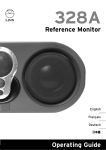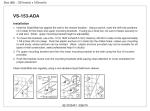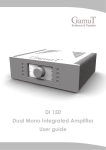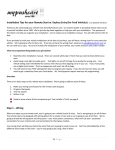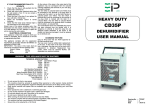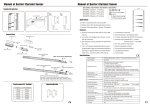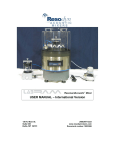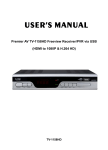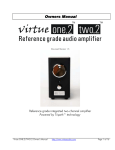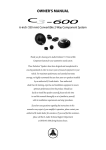Download M®inenT User manual - Klang-Form
Transcript
M®inenT User manual M3, M5 & M7 Speakers www.gamutaudio.com © GamuT Audio, All rights reserved, GamuT Audio, Siggaardsvej 2 - DK6818 Aarre - Denmark Introduction The materials and constructions chosen for a GamuT product will make it last a life time and give you years of musical enjoyment. Thank you for choosing a GamuT product. With the M®inenT Series we are giving you all our know-how from the El Superiores plus a great package of newly developed solutions to give you an exquisite yet affordable package, all made in Denmark with the use of superior craftsmanship. The further expanded value for money, we owe to the new enclosure using the Low resonance Hornflex® design to further minimize stored energy, and the new spike system that allows easy set and perfect grounding even on heavy carpeting. A new Tweeter was also designed to eliminate overexposure to transient/resonant signals from the recorded material, and the new Woofer for the M5, and Woofers for the M7, were designed to give more weight and authority to the lowest octaves. The Mid-Woofer used in the M3 and M7, the NRLI Network, the DC coupled midrange and the Internal Dynamic Damping Dividing we all inherited directly from the El Superiores. Setting up A speaker is an acoustic instrument; it will work with your room and generate a combined character. To minimize the negative influence from the room and optimize the linearity of the combined reproduction please follow the simple guide lines below. To fine trim the performance, go to the advanced setup section. Distances are measured from the Tweeter. Minimum recommendations in a regular setup: Distance to side walls: 4’ or 1,2m Distance to the rear wall: 3’ 4” or 1,0m With the “Narrow room” setup (excessive toe-in where axis meet in front of the listening position): Distance to side walls: 2’ 4” Distance to the rear wall: 4’or 1,2 m With both the regular setup and the Narrow room setup, position you speaker a minimum of 10’ or 3m apart and the listening position a minimum of 10’ or 3m from the speaker. With a regular setup point the speaker straight forward. With the Narrow room setup (where the 3’ clearance to the side room cannot be achieved, requires a 16’ wall distance) toe-in the speakers so that the axis of the tweeter is crossing app. 2’–3’ or 60–90 cm in front of the listening position. Adjust the spikes so that a line starting from the top point of the Midrange (the driver below the tweeter), and running in parallel with the top of the speaker, is pointing to your ear height in the listening position. If trimming of the bass, midrange or tweeter level is needed; you can adjust the Bass balance by changing the position of the speaker, the midrange character by adjusting the tilt of the speaker, and the tweeter level by adjusting the toe-in. Visit the advanced setup section for instructions or e-mail us at: [email protected] 2 M®inenT User manual – M3, M5 & M7 Speakers Connections Spike adjustment: The new Spike system is designed to penetrate heavy carpeting, by using a sharply shaped center Spike. The Spike is locked by the outer Knob. Loosen the knob counter clockwise to allow adjustment of the Spike. Use an Allen key (Unbrako), size 6 mm, to adjust the spike. Adjust the spikes to have an even weight distribution (same slight resistance when turning the key) to eliminate movement of the speaker. When the Speaker is positioned in its desired position turn the outer Knobs Clockwise by hand, until they lock, to lock the spikes. Connecting to the amplifier: The newly designed proprietary GamuT Terminals are made to allow the use of 3 different connections: 8mm spades, 4 mm banana plugs or stripped wire (Bi-wire only). The terminals come with a connector bracket to connect the two pairs of terminals. The upper pair is input for the Tweeter, the lower pair is input for the Mid/ Woofer section. To optimize for Bi-wiring remove the bracket by removing the terminal nuts. (The positive input is on the right hand side viewed from the back). Connect your speaker cable to the speaker before connecting to the amplifier. • For single wire connection we recommend using the + input for the tweeter (upper right terminal) and the – input for the Mid/Woofer (lower left terminal). • When using Banana plugs insert the plugs in the center hole, make sure the fit is as tight as possible. • When using a Spade, loosen the desired terminal nut and insert the spade between the terminal and the bracket (single wire use). • When using a stripped wire remove the terminal nut and insert the stripped wire into it. Position the stripped wire onto the conical part of the terminal base and re-position the terminal nut onto the thread and turn the nut until it locks the wire. M®inenT User manual – M3, M5 & M7 Speakers 3 Optimizing the sound 1. Running in (breaking in): 2. Advanced setup: Running in (breaking in): Speakers are electro mechanical devices. As any mechanical device a speaker needs running in before it reaches its optimum performance level. During the development phase we have carefully aligned and trimmed all components to have a perfect balance when fully run in, so please allow for the speaker to have a run in period of up to 200 Hours of music playing and an ageing of minimum 6 months before they reach their optimum performance. During the run in period the final positioning of the speaker cannot be determined as the bass character will change. Please also allow time for the mid and tweeter character to fall into place. • Positioning; Optimizing the Bass character & balance: Please go to the “Setting Up” section to find the minimum distances to walls etc. and choose your way of setting up: “Regular” or “The Narrow Room” setup • A room has standing modes of energy. The most harmful modes are positioned in multiplications of 1/2 fractions of the room dimensions, I.e. the position where the room length, width and height is divided with 2, 4, 8, 16 etc. The obvious solution is to avoid these positions by positioning the speaker in uneven fractions of the room dimensions. • The preferred divisions of room dimensions are: 1/3, 2/7, 1/5 & 1/7 see the diagram below. Example Measurements Results Divided by 7 Divided by 5 2× divided by 7 Divided by 3 2× divided by 5 3× divided by 7 Example width 5 meters 0,72 1,0 1,44 1,67 2,0 2,16 Example length 7meters 1,0 1,4 2,0 2,33 2,8 3,0 Divided by 5 2× divided by 7 Divided by 3 2× divided by 5 3× divided by 7 Your measurements Measurements Results Divided by 7 Your measured width – write here Your measured length – write here 4 M®inenT User manual – M3, M5 & M7 Speakers • The process to calculate is to draw your room with measured dimensions and draw lines with the specified divisions of the dimensions both length and width wise. Choose the positions that exceed the minimum requirements for clearance to the walls and allows the minimum spacing between the speakers. Speaker Width /7 Width /5 2 × Width /7 Length /7 2 × Length /7 You have 6 possible listening positions Length /5 Length /3 Where each of the measured lines cross, you have a possible speaker position. Length /5 2 × Length /5 Length /7 2 × Length /7 3 × Length /7 • Tilting; Optimizing the midrange character: Use the guidelines from the “Setting Up” section to adjust the tilt of the speakers. Adjustments of the tilt of the speaker will have the following sonic effect: By tilting the speaker towards the front, i.e. leaning more forward, the midrange character will be more aggressive or “forward”. By tilting the speaker towards the back, i.e. leaning more backwards, the speaker will be less aggressive or “laid back”. Fine trim the speaker tilt to optimize the midrange character. M®inenT User manual – M3, M5 & M7 Speakers 5 • Toe-in: Optimizing the tweeter character: You have chosen to setup using the “Regular” or the “Narrow Room” setup. By adjusting the toe-in the tweeter level and character can be optimized • In a “perfect” acoustic environment our speakers are designed to be listened to app 20-25 degrees off axis, which corresponds to a normal setup with the speakers close to pointing straight. By using toe-in the tweeter will point more towards the listening position thereby increasing its level, as the highest level from the tweeter is obtained directly on axis. • In the Regular Setup, with the tweeter axis pointing close to straight, use toe-in to increase the tweeter levels, and use toe-out to decrease the tweeter levels • In the Narrow Room Setup, The tweeter axis is toed-in to meet in front of the listening position. To increase the tweeter levels toe-out the speakers, and to decrease the tweeter levels toe-in the speakers. Please note that the increase/decrease in toe when using this solution is more critical compared to using the Regular setup, only a few degrees change of Toe will cause a great change in subjective tweeter level. The Narrow Room Width /7 Length /5 The optimized low frequency speaker location More high frequency; less toe-in / pointing more directly to the ear Less high frequency; more toe-in Width /7 6 M®inenT User manual – M3, M5 & M7 Speakers The optimized listening position Care & Maintenance Maintaining the performance: Over time, a mechanical connection will loosen slightly, and will deteriorate due to atmospheric influence. To keep the optimum performance, clean and tighten the connections on a regular basis. A clean cloth slightly soaked in spirit is recommended to clean the gold plated connections and cables. Maintaining the surfaces: Clean the lacquered and fabric covered surfaces using a clean damp cloth, or a soft brush, soaked in a light detergent solution. Cleaning the Drivers: When cleaning the speaker drivers, be sure not to apply excessive pressure, these are delicate items and bending or deforming the diaphragms will deteriorate the sonic performance, a soft brush without detergent is recommended. M®inenT User manual – M3, M5 & M7 Speakers 7 Technical data Construction Bass / Mid Drivers High Freq. Driver Frequency Response Impedance Sensitivity for 2.8V Input Crossover Points Size (W × H × D) mm Weight M®inenT 3 M®inenT 5 M®inenT 7 2 Way Impulse Optimized Bass Reflex 2 Way Added Bass Impulse Optimized Bass Reflex 3 Way Dual Bass Impulse Optimized Bass Reflex 1 × 182mm Dynamic linear Mid-Woofer 1 × 182mm Dynamic Linear 1 × 182mm Dynamic Linear Mid-Woofer & Mid-Woofer & 1 × 182mm Woofer 2 × 182mm Woofer Transient correct 38mm Double Diaphragm Ring Radiator Transient correct 38mm Double Diaphragm Ring Radiator Transient correct 38mm Double Diaphragm Ring Radiator 39 – 50000 Hz 34 – 50000 Hz 31 – 50000 Hz 5 Ohms nominal minimum 4 Ohms at 220 Hz 4 Ohms nominal minimum 3,2 Ohms at 200 Hz 4 Ohms nominal minimum 3,1 Ohms at 240 Hz 88 dB 90,5 dB 90 dB 2100 Hz 530 Hz & 2150 Hz 260 Hz & 2100 Hz 400 × 226 × 456 1210 × 226 × 575 1280 × 226 × 642 22 Kg 34 Kg 45 Kg www.gamutaudio.com © GamuT Audio, All rights reserved, GamuT Audio, Siggaardsvej 2 - DK6818 Aarre - Denmark








